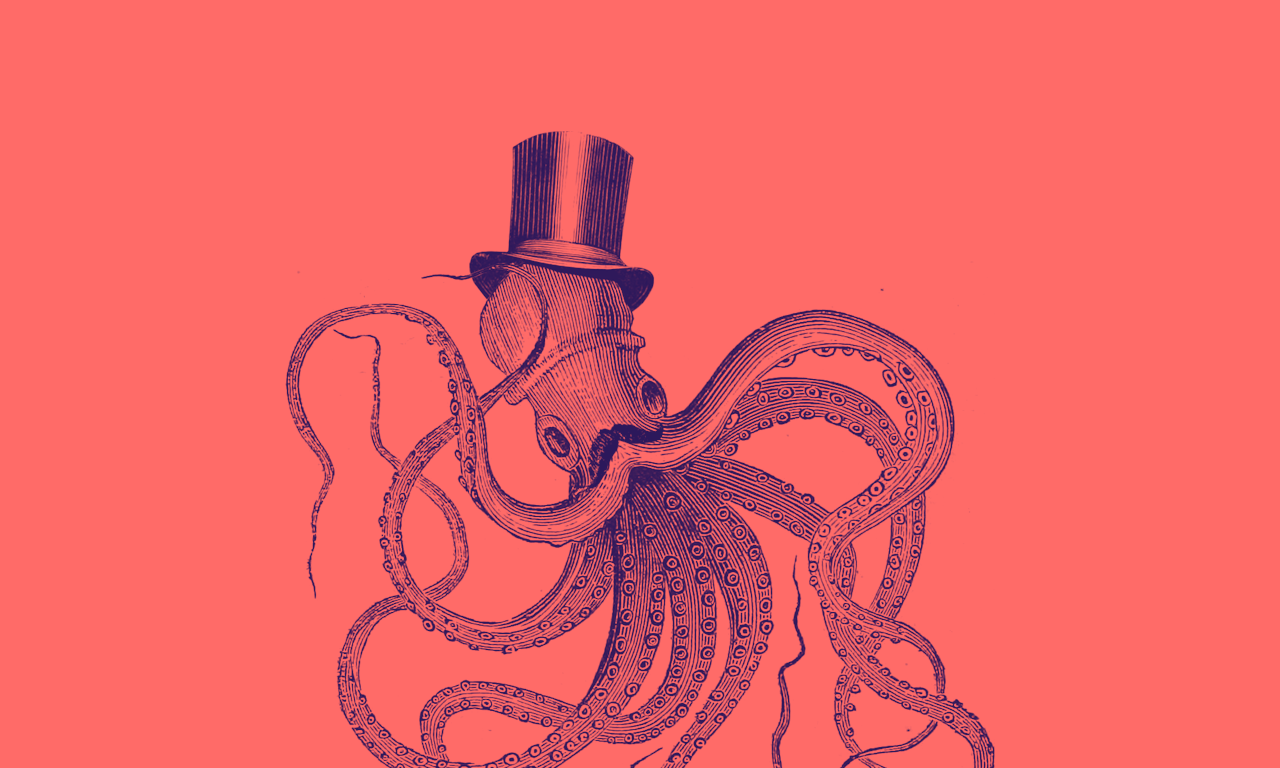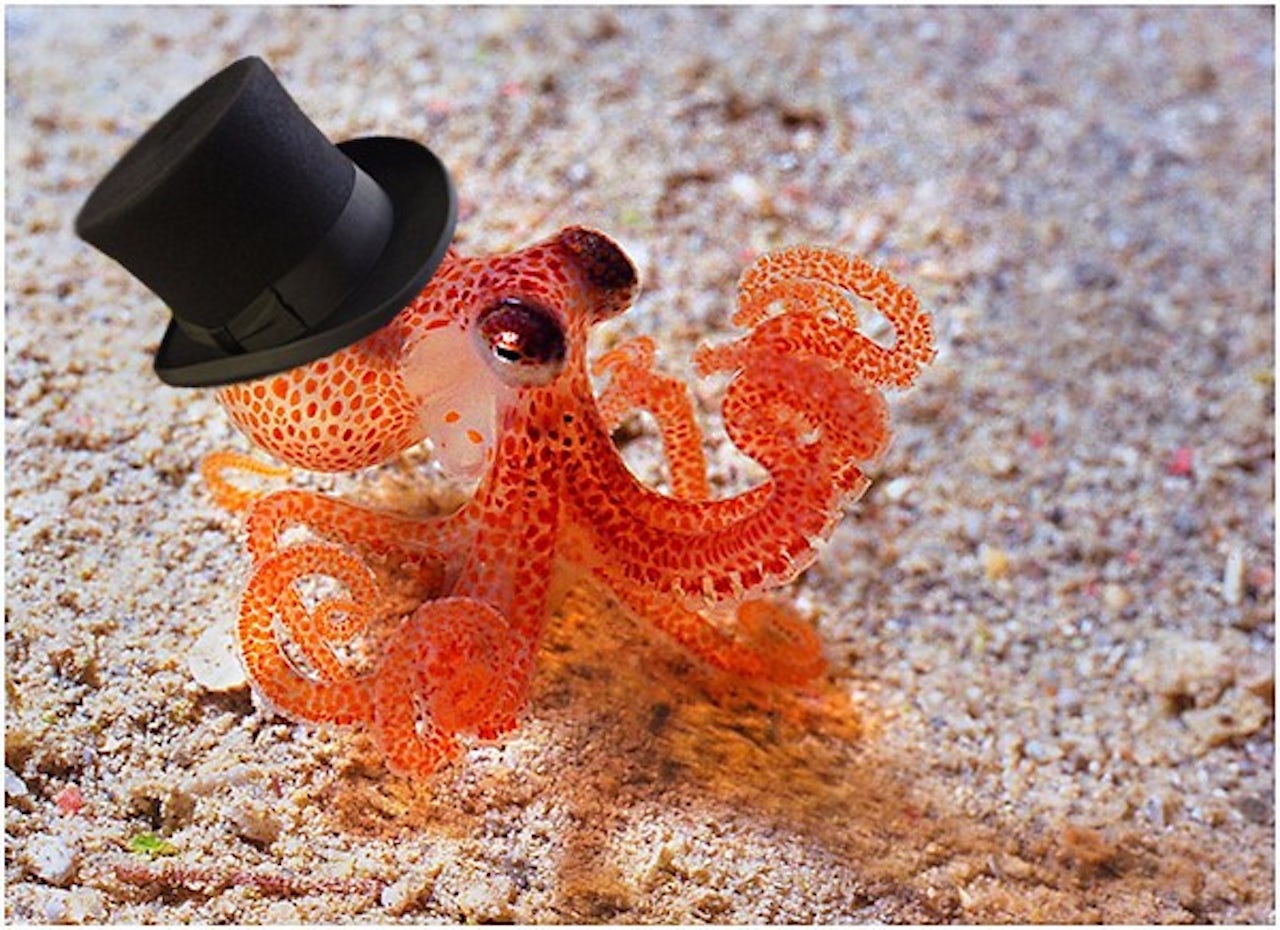When a picture of a small orange octopus hit the front page of Reddit in 2012, the top comment asked, "why the fuck doesn't he have a top hat?" Another user replied with an edited version of the original image and voilá, the octopus wore a formal black top hat, angled ever so slightly. But the demands in the comments didn’t stop there. A third user chimed in, “Now I need to see this with a monocle, cane, and classy moustache.”
You’d be forgiven for thinking that this cryptic call-and-response was another one of Reddit’s inside jokes. But it wasn’t. Depicting octopuses in top hats and other dandy accoutrements transcends any ingroup, website, or medium.
On YouTube, there are tutorials that’ll teach you how to sketch or construct your own top-hatted octopod, fully equipped with a monocle and handlebar moustache. And if you don’t want to create one, you can purchase something on Etsy, where they sell everything from wax seal stamps to washi tape decorated with octopuses in top hats.
You’re a Google away from seeing various versions of this fancy gentleman on clothing, stationery, coffee mugs, tote bags, pillows, human flesh, and steampunk blogs.
But there’s one thing you can’t find on Google: why?
How did a top hat, which to some signifies sophistication and gentility, become the go-to accessory for the octopus?
"I’ve never seen an octopus take a shit," said Kurt Gray, a social psychologist who researches the inner lives of animals at the University of North Carolina. Gray couldn’t say for sure but was willing to guess that an octopus might be more deserving of a top hat than other animals — let’s say a dog, for example — because most people have never witnessed an octopus flaunting its carnal behaviors. Meanwhile, you don’t have to look hard to find an example of a canine humping someone’s leg. To put it a different way: If white is the absence of color, then refinement might be the absence of crudeness.
“I've never seen an octopus take a shit.”
The pervasiveness of the refined octopus shouldn’t come as a surprise, though. After all, from an early age, we’re bombarded with depictions of octopuses as little gentlemen. The title character in Oswald, a Nick Jr. show that ran for one season in the early 2000s, was a roly-poly blue octopus who wore a bowler hat. Dan Yaccarino, the show’s creator, said he gave Oswald, voiced by Fred Savage, a bowler hat to make him look extra courteous because octopuses "seem like fairly genteel creatures."
And in the first season of The Powerpuff Girls, a popular Cartoon Network television show that debuted in 1998, the audience was introduced to Octi, a droopy-eyed plush octopus in a tiny black top hat. "I think it was an attempt to make him extra fancy and sophisticated," Craig McCracken, the creator of The Powerpuff Girls, said of the decision to give Octi a top hat.
Looking back, McCracken believes that Octi’s design could have been subconsciously influenced by Mr. Peanut, the Planters Peanut mascot, since "both he and Octi have that bulbous head and skinny neck."
But it turns out we’ve putting top hats on octopuses long before Planters was even a company.
The Vulgar Army is a blog devoted to cataloging the use of octopuses in political cartoons and propaganda throughout history. Illustrators have been featuring octopuses as a metaphor for corruption, imperialism, or just evil spreading across a map since the late 19th century — and they weren’t shy about using a top hat to humanize their octopuses.
A Harper's Weekly cover from 1900 depicted three octopuses in top hats with their tentacles wrapped around William Jennings Bryan, the Democratic presidential nominee that year. And John Tenniel, who famously illustrated Alice in Wonderland, once portrayed William Gladstone, the former British Prime Minister, wielding a knife against a top-hatted octopus in 1881.
One of the best-known examples from this era is "The Devilfish in Egyptian Waters," which was published in 1882, the same year British forces began to occupy Egypt. The illustration shows a half Englishman, half octopus reaching out with one appendage for Egypt while maintaining its grip on a dozen other countries. Like most 19th century Englishmen, the human-octopod is also wearing a top hat.
Was the Redditor who asked, "why the fuck doesn’t he have a top hat," referencing this satirical take on British imperialism? Maybe. Either way, it’s interesting that one of the earliest examples of forcing British culture onto an octopus is in a criticism of forcing British culture onto the rest of the world.
Jennifer Mather, a professor of psychology at the University of Lethbridge in Alberta, Canada, told The Outline not to overthink it. She teaches a course on how the media represents animals and explained that anthropomorphization is simply a way to satisfy our desire "to see animals in terms of us and our construction." As an example, she mentioned a woman she knows who makes a living selling cute hats for cats. “I can’t think of anything a self-respecting cat would like less,” Mather said. The concept of the classy cephalopod floats below the surface of the public’s conscience. But it only takes a passing reference for someone to see how curious it really is. An example: In an episode of GameGrumps, a web series about video games, the host tried to contain his laughter as he revealed to his 3 million subscribers that "octopus top hat" was among his most recent internet searches. That coincided with a 1,150 percent spike in related queries that week.


